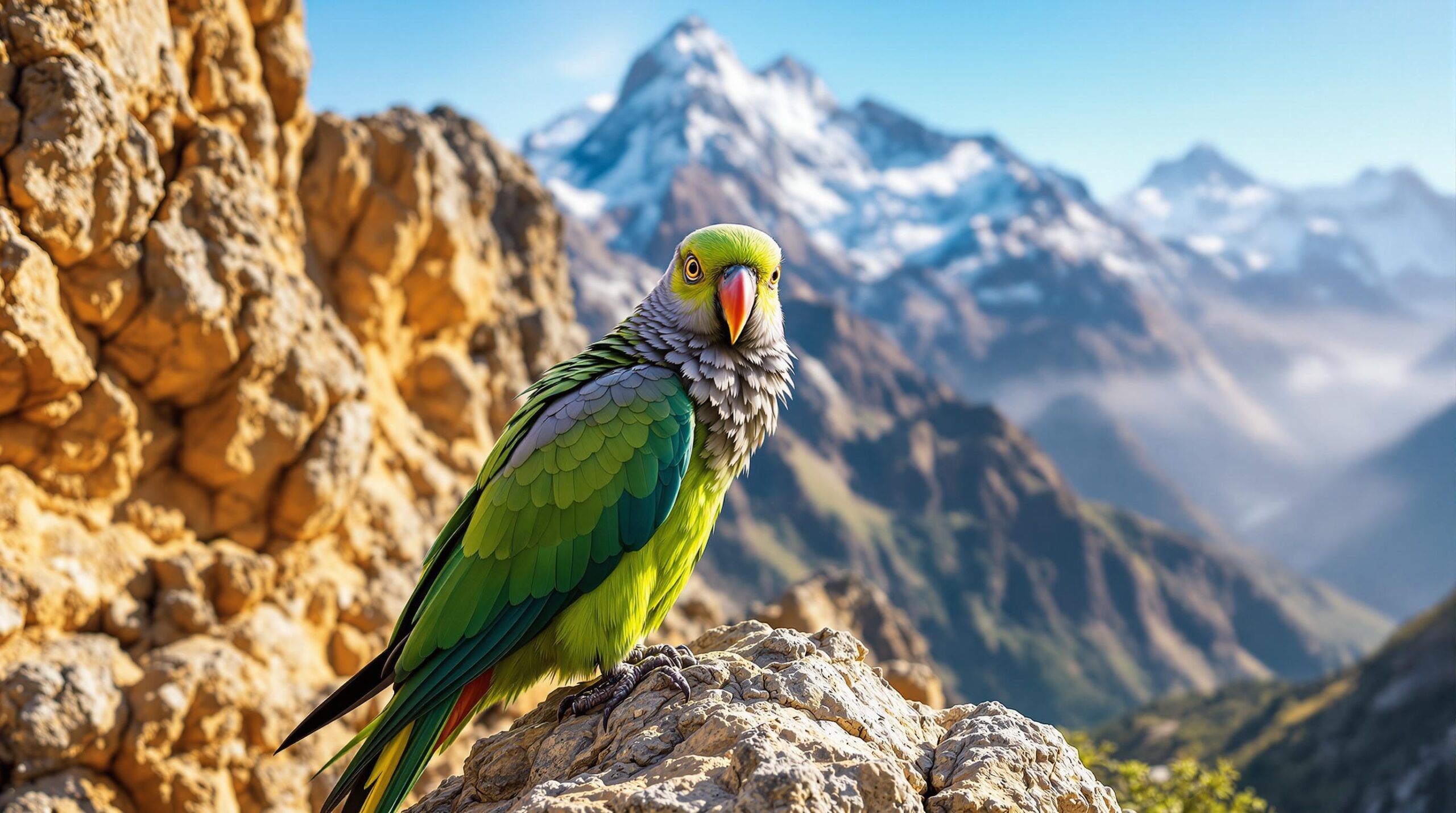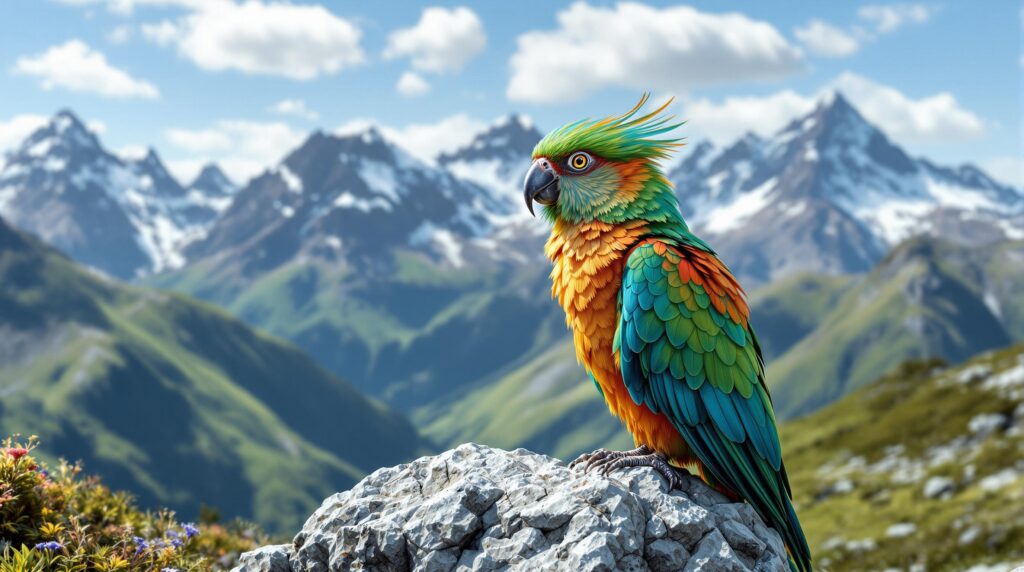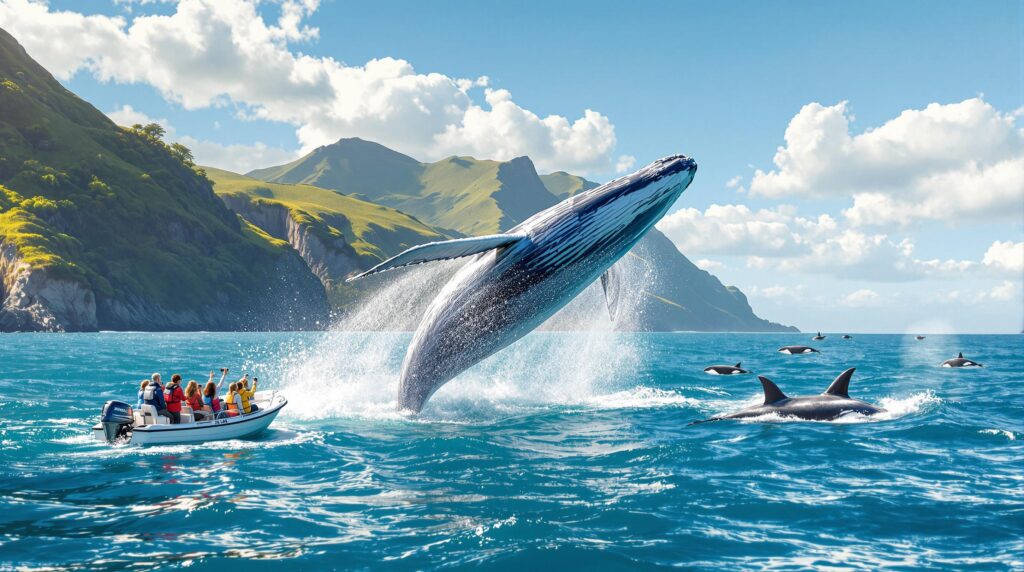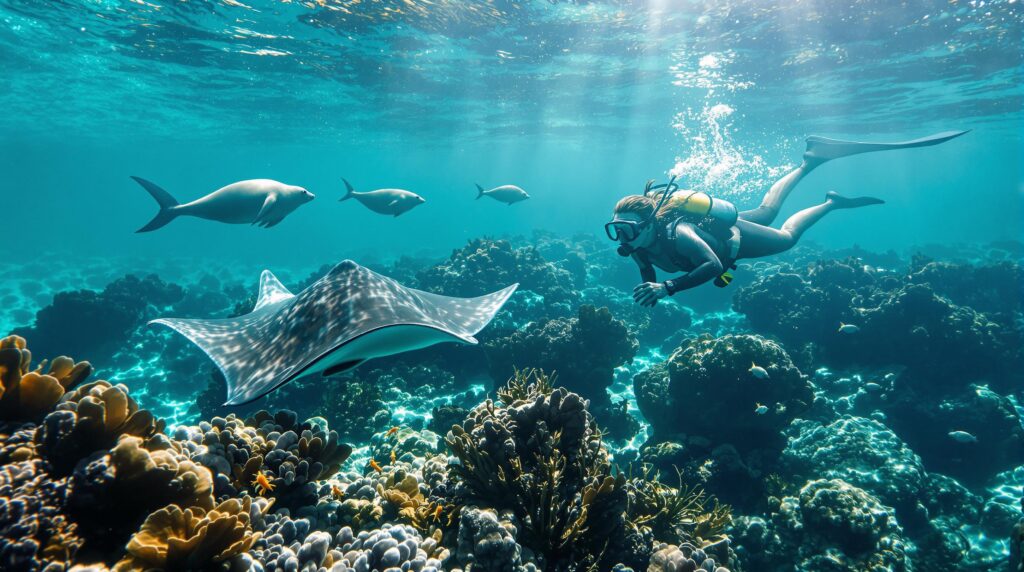Stepping into the world of the Kea Parrot has always felt like embarking on a wondrous journey through breathtaking Mountains and untamed Wildlife realms in New Zealand. As I wandered through the rugged landscapes, I discovered a unique blend of playfulness and raw survival that makes these birds so alluring. Their notorious Smart and Mischievous nature fueled both local admiration and concern. Every interaction with these curious inhabitants of the alpine regions has left an indelible mark on my spirit. Their habitat, behaviors, and conservation challenges provide a narrative that deserves to be shared for everyone seeking a real adventure in conservation and exploration.
Roaming the alpine trails and enjoying the fresh mountain air, I found that the kea’s story is much more than that of a wild parrot. It is a tale of resilience, intelligence, and a vibrant ecosystem that beckons every travel enthusiast. This heartfelt recounting weaves together scientific insights, local anecdotes, and practical advice, inviting readers to experience the allure of New Zealand’s natural wonders in an engaging, friendly tone. Along the way, I integrate links to trusted sources such as detailed kea information and local conservation efforts at New Zealand DOC to guide curious minds towards deeper knowledge.
Kea parrot ecology in new zealand’s mountains
Walking high in the alpine ranges, I encountered the charismatic kea, an emblem of Conservation challenges and natural beauty in New Zealand. My firsthand experiences on winding trails and snowy ridges gave me a clear view of how these birds live, interact, and struggle for survival in their exclusive habitat. The kea is unique as the world’s only alpine parrot, thriving in an environment where few species venture. Their habitat spans an immense area of some 3.5 million hectares, primarily on the South Island’s rugged terrain. I found this area to be a living museum of ecological diversity where each rock and stream whispers stories of evolution and survival.
Having spoken with local naturalists and conservation experts, I quickly learned that the kea’s behavior is an intricate dance of curiosity and caution. Their nesting habits, often on the ground, expose their offspring to multiple dangers, including predators like stoats, rats, and possums. These invasive species have significantly contributed to the staggering decline in kea populations, with estimates ranging between 1,000 to 5,000 individuals. Such statistics illustrate a crisis that calls for urgent conservation measures. In conversations with experts from the Kea Conservation Trust, it was evident that ecological balance in these mountainous regions is fragile yet awe-inspiring.

habitat and behavior characteristics of the kea parrot
On my many hikes into the alpine realms, I was always struck by the kea’s versatility in adapting to harsh climates. The kea’s habitat is not only defined by its breathtaking landscapes but also by the complex interplay of nature and human influence. Nesting on the ground offers protection and easy access to food, but it simultaneously places these birds in the crosshairs of predators. Watching them in their natural setting, I noted a blend of caution and playful boldness that accentuated their innate curiosity. The birds, often seen approaching hikers with an inquisitive tilt of the head, highlighted their Mischievous character and their penchant for exploration. This playful behavior, which sometimes verges on raw audacity, is part of what makes them so appealing to enthusiasts and yet controversial among local populations.
The kea’s daily life is punctuated by interactions with both natural predators and human activities. A startling revelation during my journeys was learning how human-made structures, like old alpine huts and shearing sheds, contribute to chronic lead exposure. Such poisonings have been linked to serious health impacts, including neurological damage and increased mortality. The intersection of human development with nature’s delicate tapestry poses a significant threat to these Endemic birds. I found that many local conservation groups, including those represented on platforms like DOC Kea Projects, are actively working to mitigate these challenges. Their efforts reflect a deep-seated commitment to preserving nature’s intricate networks in the face of modern adversities.
During one of my hikes, I encountered a table created by local researchers detailing kea nest survival statistics. The table highlighted alarming figures—almost two-thirds of kea chicks fail to reach fledgling stage, a consequence of predation and environmental hazards. Below is a snapshot of the data:
| 🐥 Stage | 🌟 Survival Rate | 📉 Threat Level |
|---|---|---|
| Egg | 70% | ⭐ Moderate |
| Nestling | 40% | ⭐⭐ High |
| Fledgling | 20% | ⭐⭐⭐ Critical |
Such data paints a vivid picture of the hurdles these birds face daily. The complex ecosystem they inhabit, where every natural element and mankind’s touch intertwine, serves as a stark reminder of both nature’s resilience and fragility. Conversations with local guides revealed that keeping vehicles, tents, and other structures away from nesting sites is crucial for reducing lead poisoning hazards. For more insights, I often refer to detailed articles on New Zealand’s wildlife conservation efforts.
Local experts also mention that some people view kea as pests primarily because of their habit of damaging cars and curious exploration of human campsites. Despite these challenges, their trailblazing spirit continues to shine. This delightful contrast of destruction and endearing curiosity makes the kea a complex figure in New Zealand’s natural mosaic, blending the thrill of an adventure with the sober reality of conservation issues.
Interactions with these birds during late afternoon hikes were unforgettable. I vividly recall moments when the kea would approach, almost inviting you to join in their lively frolic. I was reassured to know that similar experiences have been documented in studies, such as those published in notable media outlets, which shed light on their playful nature. The paradox of their friendly demeanor versus the mounting conservation challenges is what propels the local conservation agenda forward. Their behavior, a blend of smart tactics and mischievousness, makes every encounter a learning opportunity about adaptation under pressure.
Smart and mischievous behavior patterns of the kea parrot
I have always been fascinated by the kea’s Smart and Mischievous reputation, a duality that reveals much about their interaction with the environment. As I ventured deeper into the rugged mountains, I noticed that their playful antics were not merely random acts. Researchers have identified that these birds demonstrate behaviors that could be compared to what scientists refer to as “positive emotional contagion” in humans, akin to an infectious laugh that invites playful chaos into their surroundings.
One of the most striking observations is when the kea initiate playful contests. In many instances, even a simple call associated with play is enough to trigger spontaneous bouts of aerial acrobatics and object tossing. I recall a memorable day in Arthur’s Pass National Park where a recorded play call led to an immediate change in the birds’ behavior; a quiet scene turned into a burst of lively pursuits. Their actions were not linked to mating or searching for food, but rather appeared as self-initiated expressions of pure, joyful interaction.
Having spent days in the wild, the kea’s capacity to solve problems and find innovative ways to seek fun became increasingly evident. Their intelligence is not confined to a single trick—these birds have been observed mimicking human activities and even using tools to explore their surroundings. This playful curiosity is what defines their character and cements their place as one of the most Smart creatures in the avian world. It is truly an adventure to witness such behavior in its raw form.
Exploring their cognitive abilities, I often researched their problem-solving techniques and noted studies that illustrate their capacity to learn from interactions. For instance, video recordings on platforms like
provide real-life examples of kea engaging in activities that blend mimicry and play. In every instance, their actions reminded me that beneath a seemingly mischievous exterior exists a level of intellect that few species can match. This blend of play and intelligence makes the kea an emblem of Adventure in the wild, evoking the spirit of nature’s most enchanting puzzles.
When I sat by a mountain stream, the kea’s actions struck a personal chord. Their willingness to interact with humans, often approaching with an almost friendly demeanor, underscores an unusual trait among wild birds. This behavior, while endearing to visitors, poses significant challenges when human interaction leads to unintended consequences like food scavenging or vehicle damage. It is essential, based on observations and conversations with local authorities—such as insights shared on Milford Sound Luxe Tours—to maintain a respectful distance to allow these birds to continue their natural behaviors without harmful interference.
During one trek, I compiled a list of playful behaviors that perfectly encapsulated the kea’s character. Here are some of the delightful traits observed:
- 👍 Creative problem-solving: using available resources to challenge themselves
- 🔥 Infectious laughter: a playful call that triggers group play
- 🌟 Exploratory behavior: approaching human campsites with curiosity
- 😊 Social interactions: engaging with other kea in seemingly joyful contests
- ✌️ Adaptive learning: figuring out human-made puzzles and obstacles
These everyday displays stand as vivid reminders that these birds are not merely survivors but innovators and playful spirits. Their antics light up the cold alpine air, creating moments of laughter and delight that resonate with every explorer. The harmony between their innate intelligence and the environmental pressures they face creates a narrative that is as educational as it is captivating. For those interested in more detailed behavioral studies, I recommend checking out resources like the Kea Conservation website, which further explains these phenomena.
The interplay of natural instincts and environmental challenges transforms the kea from a mere subject of study into a living symbol of nature’s relentless drive to engage, adapt, and survive. Their playful nature, combined with innate curiosity, brings comfort and wonder to anyone fortunate enough to witness their charms up close. It’s a vibrant testament to the delicate balance of Conservation and the necessity of safeguarding these wild treasures for future generations.
Conservation challenges and wild adventure encounters
Traversing the untamed alpine roads, I encountered the bittersweet reality of conservation challenges that accompany such a unique species. The kea’s plight is multifaceted, intertwining natural and human influences in a tapestry of struggle and hope. Despite their resilience, these birds face relentless challenges that jeopardize their very existence. With threats from non-native predators, the lurking danger of lead poisoning from old buildings, and direct human conflict, every encounter with the kea becomes an exploration of nature’s precarious balance.
Over the years, I have engaged in numerous conversations with local environmentalists who are ardently working to protect the kea. Their insights are shared generously by trusted groups such as World Parrot Refuge and are backed by ongoing research initiatives. A recurring theme is the alarming rate of nest failures. Ground-dwelling nests leave young kea vulnerable—statistics indicate a significant loss from the egg stage through fledgling days. These facts are a harsh reminder of the urgent need for active Conservation strategies in a region increasingly dominated by human footprints.
During a multi-day expedition, I recorded detailed observations of signs that reflect both the beauty and the cruelty of nature. Small signs of human impact were evident in the form of abandoned alpine huts and shearing sheds that inadvertently expose the birds to toxic lead levels. I learned that lead poisoning can have drastic, even fatal, effects—ranging from neurological damage to immediate mortality. Even with protective measures being put in place, incidents continue, marking a bitter chapter in the kea’s story. Local authorities have pledged large-scale eradication of predators such as stoats, rats, and possums, as seen on platforms like DOC Kea initiatives, but the challenge remains colossal in the vastness of New Zealand’s mountains.
A detailed table compiled by one local conservation team highlights various human-induced and environmental threats, aiming to educate locals on how to minimize risks. This table helped me understand the interaction between human developments and the kea’s natural behavior:
| 🚨 Threat Factor | 🌠 Impact Level | 🛠️ Mitigation Measures |
|---|---|---|
| Lead poisoning | ⭐⭐⭐ Critical | 🔧 Restoration of old structures |
| Predation | ⭐⭐ High | 🛡️ Predator control programs |
| Habitat disruption | ⭐⭐ Moderate | 🌳 Preservation of natural zones |
Local community initiatives seek to combine education and practical action. On several hikes, I met folks who cared passionately about both their local economy and nature’s integrity. Their tips for safe and respectful wildlife observing included maintaining a respectful distance, not leaving food scraps behind, and advocating for minimal infrastructure in sensitive areas. These practical steps, shared on platforms like Explore New Zealand, amplify each individual’s role in protecting these incredibly vulnerable parrot populations.
The blend of regulatory measures and community-led monitoring shows that the effort to conserve the kea is a collective mission. I have seen firsthand how the kea fosters a deep sense of community among conservationists. The mutual respect for nature, combined with a shared sense of adventure, fuels a movement that transcends simple wildlife management. The challenges are daunting, yet every small victory—a nest left undisturbed, a safe migration route, or simply a kea observed playing in its natural habitat—serves as validation that our shared efforts are worthwhile.
Daily encounters with kea during my mountain adventures reiterate the intrinsic need for balance between human development and the pure, unblemished rhythms of nature. This balance is essential for maintaining the wild spirit of New Zealand’s alpine regions and ensuring that these intelligent birds have the safe environment they require to continue thriving. The kea’s journey, marked by its Mischievous charm and formidable survival challenges, underscores the interconnected nature of adventure and conservation. It is a narrative that continues to inspire both policymakers and nature enthusiasts alike, urging us to be mindful and proactive in preserving one of the world’s most remarkable wildlife phenomena.
Exploring new zealand kea parrot culture and adventure opportunities
Spending days amid the frozen peaks and green valleys of New Zealand has introduced me to a cultural tapestry where nature, adventure, and community intermingle wonderfully. Every rocky path and secluded mountain pass has its own story to tell, and the kea—a resilient, Smart and Mischievous parrot—plays an integral role in these narratives. This journey is as much about discovering hidden trails as it is about learning from the local communities who have embraced the kea with open hearts and minds. The intricate relationship between the locals and their feathered neighbors has enriched my travel experiences, offering invaluable perspectives on sustainable living and nature conservation.
My wanderlust took me to remote areas where local guides shared treasured insights about managing the delicate interactions between human structures and natural ecosystems. I was shown the best spots for birdwatching, often off beaten tracks where the clear mountain air mingles with the sound of playful kea calls. I have learned that these journeys require not only physical stamina but also an empathetic understanding of nature’s subtle cues. It is a vibrant adventure that calls on every explorer to appreciate the finer details of wildlife behavior, particularly that of the kea—a true icon of the alpine.
Local craft shops and cafés often display memorabilia and local art that celebrate the kea. I remember sitting down with a local artisan who explained how the kea has inspired traditional carvings and vibrant paintings, linking nature’s wild beauty with enduring local artistry. Some of my favorite experiences were shared over a cup of freshly brewed coffee, where stories of old mountain legends unfolded alongside modern conservation struggles. I find it deeply moving when art and nature combine so harmoniously. Resources like NZ Geographic further detail many of these local cultural ties, offering an in-depth look at how artistic expressions mirror the kea’s playful yet challenging existence.
The balance between adventure and respect for nature is also captured in practical tips offered by local experts. Here are some insightful gems I noted on my travels:
- 🌄 Plan ahead: Ensure you research local trail information and weather conditions.
- 🎒 Pack responsibly: Carry only what you need to reduce waste in fragile environments.
- 🐾 Respect wildlife: Observe from a distance and avoid direct interactions that may harm natural behaviors.
- 🗺️ Engage local guides: Their intimate knowledge of the terrain and the kea is invaluable.
- 💚 Support conservation: Contribute to local conservation projects and organizations.
For a practical comparison of various adventure packages that incorporate wildlife conservation experiences, I put together an illustrative table that categorizes some of the best local adventure brands. These packages not only highlight respect for nature but also embody the spirit of exploration inherent in New Zealand:
| 🏷️ Brand | 🌟 Adventure Type | 💼 Focus |
|---|---|---|
| WildNZ Adventures | ⭐⭐⭐ Mountain Trekking | Wildlife & Conservation |
| Alpine Quest | ⭐⭐ Nature Walks | Local Culture & Sustainable Travel |
| Summit Trails | ⭐⭐⭐⭐ Extreme Exploration | Adventure & Eco-Tourism |
Recent conversations with locals and conservationists left me with a deep appreciation for their tireless efforts to protect the kea. Many of these experts actively share their knowledge on social media platforms, allowing enthusiasts from around the globe to contribute to this shared cause. I often check The Guardian and NPR for updates on the latest conservation news and inspiring success stories. Such platforms highlight the multifaceted approach needed to cherish and protect these charming, yet imperiled creatures.
The shared passion for these remarkable birds unites travelers, scientists, and local residents, inspiring adventures that are as educational as they are thrilling. I have been fortunate to play a small part in this ongoing narrative by embracing the raw beauty of nature, engaging in respectful exploration, and continuously learning about the intricate balance required to preserve one of New Zealand’s most treasured species. Each journey reinforces my belief that protecting the kea and its alpine home is not just a conservation duty but a celebration of life itself—a wild, unpredictable adventure that calls out to the heart of every true explorer.
FAQ on kea parrot conservation and adventure
Q1: What makes the kea parrot unique among mountain birds?
A: The kea parrot is the only alpine species in the world. Its blend of Smart problem-solving skills and Mischievous playfulness makes it an exceptional symbol of New Zealand’s rugged Wildlife and a living testament to nature’s ability to adapt in extreme Mountains environments.
Q2: How do human activities affect the kea’s survival?
A: Human impacts include habitat disruption, lead poisoning from old alpine structures, and direct encounters that sometimes lead to harmful interactions. Effective Conservation efforts, such as predator control and habitat restoration, are crucial to safeguarding these birds for future generations.
Q3: What should visitors consider when exploring areas inhabited by kea?
A: Visitors should respect wildlife by observing from a distance, not feeding the birds, and minimizing any interference with their natural behavior. Supporting local guides and following responsible tourism practices helps ensure the safety of these unique birds while enhancing your own Adventure experience.
Q4: Are there any local organizations dedicated to kea conservation?
A: Yes, several organizations including the Kea Conservation Trust actively work on safeguarding kea through research, public awareness, and direct conservation initiatives. They offer valuable guidance for both locals and visitors on how to coexist with these fascinating birds.
Q5: What aspects of kea behavior indicate their intelligence?
A: The kea’s ability to solve complex problems, learn from experiences, and engage in playful interactions—sometimes even initiating what appears to be an infectious laugh during group play—highlight their remarkable cognitive abilities and vibrant spirit.
Hi, I’m Mark, a 38-year-old travel writer who traded his backpack for a peaceful life in New Zealand. After exploring dozens of countries, I’ve found my home among native bush, coastal walks, and the welcoming spirit of Kiwis. I now write about hidden gems, soulful places to stay, and local tips to help travelers experience the real New Zealand – slow, beautiful, and full of meaning.



